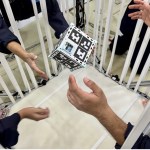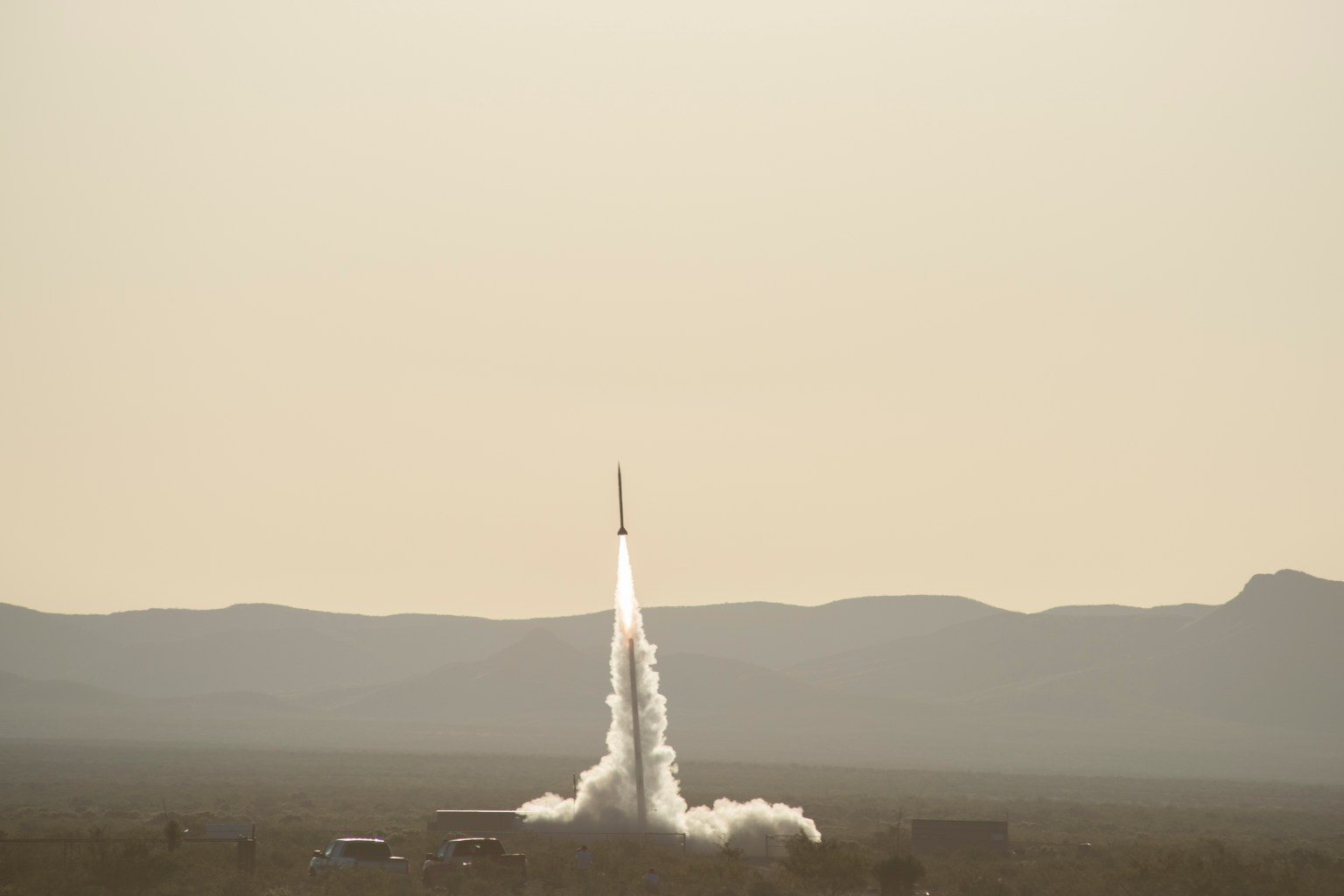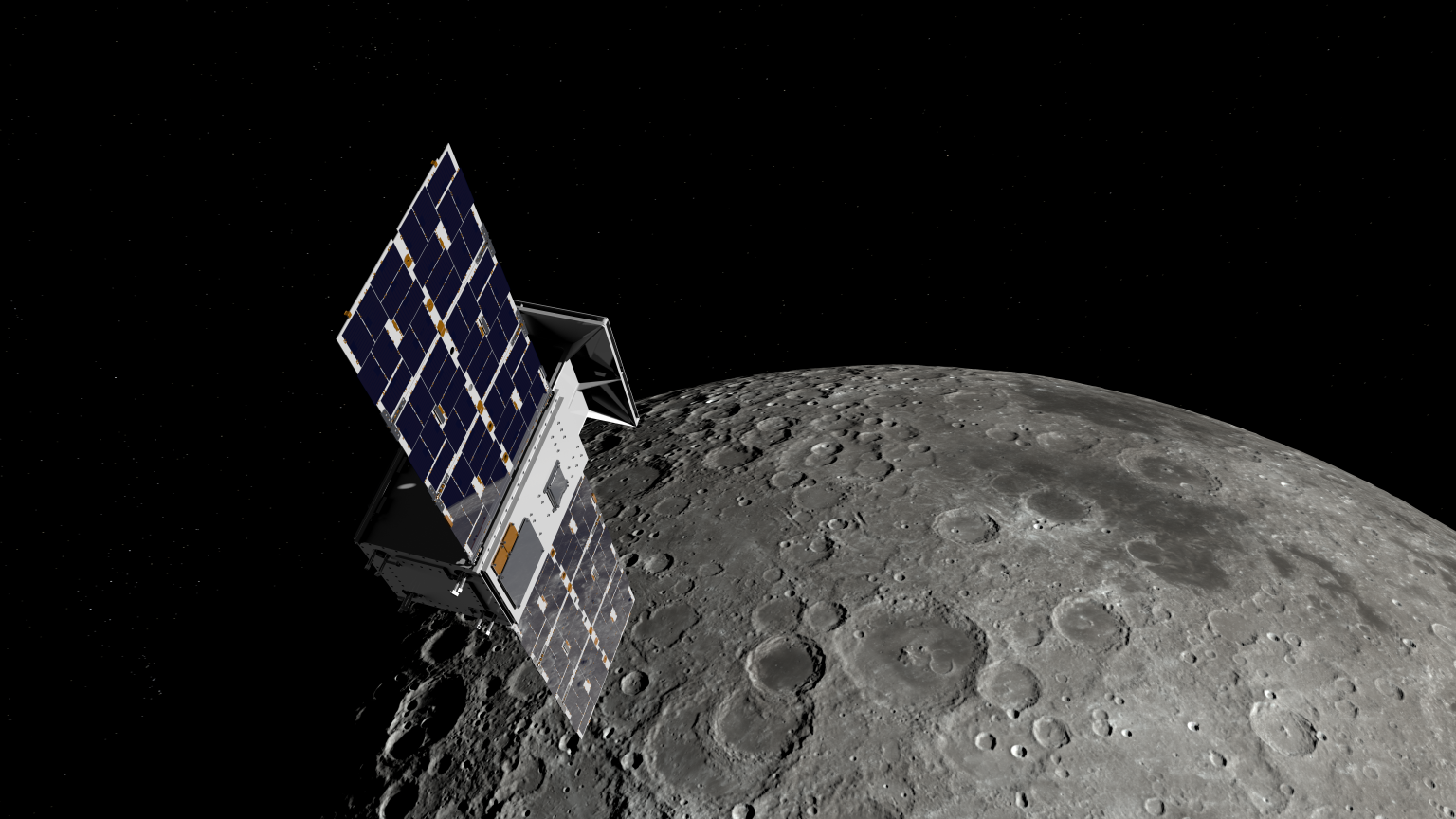Flight Opportunities
Flight Summaries
Each year, Flight Opportunities supports flight tests of dozens of program-funded technologies on commercial vehicles.
Here you will find highlights of those flights and links to additional information about the tested innovations tested aboard.
Subscribe to the Flight Opportunities newsletter about Flight Summaries
2024 Flights
Upcoming Flight
Flight Testing Gene Expression Technology
NASA’s Flight Opportunities program is supporting a University of Florida technology that helps researchers understand the biological effects of changes in gravity by analyzing patterns of gene expression in plant samples.
Principal investigator Robert Ferl will conduct this experiment himself on an upcoming suborbital flight test operated by Blue Origin, representing the first time a NASA-funded researcher is flying with their payload on a suborbital rocket. Part of the agency’s Space Technology Mission Directorate, Flight Opportunities rapidly demonstrates space technologies through suborbital flight testing with industry providers. This flight test was funded by a grant through the program’s TechFlights solicitation with additional support from NASA’s Division of Biological and Physical Sciences.
Learn more about this experiment about Flight Testing Gene Expression Technology
June 8, 2024
Flight Test Sheds New Light on In-Space 3D Printing, Propellant Slosh
Two payloads from U.S. universities soared to space aboard Virgin Galactic’s VSS Unity for suborbital flight tests funded by NASA’s Flight Opportunities program.
A payload from University of California, Berkeley tested a multi-material manufacturing technique known as computed axial lithography, a new type of 3D printing. Rather than printing in layers, this device uses light to solidify liquid and gel materials in a single step in microgravity. Future uses could range from printing spare parts for spacecraft to addressing medical-related issues during long-duration missions — all necessary to enable future long-duration space missions for NASA and the world.
A Purdue University payload studied how the sloshing of liquid propellant affects spacecraft pointing — maneuvers that orient a vehicle for docking or Earth reentry and help optimize imaging satellites orbiting the Earth, Moon, and Mars. The measurements made during this flight test could improve precise modeling of slosh in microgravity, which can’t be done through testing on Earth and could meet an essential need for future space flights that use liquid propellant.

Technologies tested on the above campaign:
- Computed Axial Lithography for Rapid, Volumetric Additive Manufacturing
- Spacecraft Pointing Control and Zero-Gravity Slosh (Knowledge Payload)
Spring 2024
Testing In-Space Manufacturing Techs and More in Flight
NASA’s Flight Opportunities program supported the testing of a variety of technologies on a series of parabolic flights in spring 2024 aboard Zero Gravity Corporation’s G-Force One.
Researchers collected data for payloads that address several technology shortfalls across the civil space ecosystem – from advanced manufacturing and entry, descent, and landing technologies to cryogenic fluid management needed for long-duration space missions and more. Check back soon for more information on all payloads. The spring 2024 parabolic campaigns ran February 26-March 1 and March 5-8 as well as in April.
Learn more about this campaign about Testing In-Space Manufacturing Techs and More in Flight
Technologies tested on the above campaign also had support from:
- In Space Production Applications
- Game Changing Development program
- Small Business Innovation Research / Small Business Technology Transfer program
2023 Flights
December 19, 2023
Suborbital Flight Testing of a Range of Technologies for Space Exploration, Discovery, and Commerce
The 14 technologies aboard the flight aim to address some of the opportunities and obstacles presented by humanity’s sustained presence in space. The flight at Blue Origin’s Launch Site One in West Texas was also a significant milestone for the company, serving as the return to flight with their New Shepard reusable suborbital rocket.
The payloads reached altitude of 351,248 feet, which exposed them to about three minutes of microgravity. Such flight conditions enabled research teams to collect data that will help them evaluate the performance of their technologies and make any necessary improvements before potential future use in space. The suborbital flight test included a range of technology capabilities for space exploration, discovery, and commerce.
Learn more about this flight about Suborbital Flight Testing of a Range of Technologies for Space Exploration, Discovery, and Commerce
Technology tested on the above campaign:
- A Suborbital Evaluation of Paraffin and Beeswax Formation in Microgravity for Low-Earth-Orbit Propulsion Applications (MIT)
- In-Space Biosensors Batch Coating Using Self-Assembled Monolayers (Ecoatoms Inc.)
- Developing autonomous hardware for use on suborbital flight to evaluate the impacts of launch and landing on Candida albicans adaptation to spaceflight (Montana State University)
- Electrophysiology Recording of Neuronal Networks During Suborbital Spaceflight (imec USA)
- Functional Integration of Lens Free Imaging in Suborbital Flight (imec USA)
- Exploring Electrostatic Regolith Interactions in Low Gravity (University of Central Florida)
- ASSET: Asteroid Soil Strength Evaluation Tool (Honeybee Robotics Ltd.)
- Demonstration of Multiphase Microfluidics for Chemical Analysis Systems (NASA’s Jet Propulsion Laboratory)
- Propellant Gauging During On-Orbit Refueling and Transfer Operations (Carthage College)
- Zero-g Slosh Model Technology (Purdue University)
- DMEN: Draper Multi-Environment Navigator (Draper)
- Transport Properties of Fluids for Exploration (University of Alabama)
September 12-October 4, 2023
Dust Sensor to Aid Lunar Landings
This technology could improve lunar landings by measuring the size and speed of surface particles kicked up by the exhaust from a rocket-powered lander. The payload testing involved a series of four tethered flights on Astrobotic’s Xodiac rocket-powered lander in Mojave, California.
When spacecraft land on the Moon or Mars, the rocket exhaust plume interacts with the surface. This interaction creates regolith ejecta – abrasive dust and large particles moving at high speeds – that can damage the lander and surrounding structures. Understanding how a rocket engine’s exhaust affects this ejecta will help mission designers plan more effectively for lunar landings. Researchers at the University of Central Florida developed an instrument named Ejecta STORM (Sheet Tracking, Opacity, and Regolith Maturity) to answer this need while embracing the Flight Opportunities program’s “fly, fix, fly” ethos to quickly advance the technology. After flight tests in 2020, researchers tested the Ejecta STORM technology’s integration with a lander and operation in flight conditions that simulated the plume effects of a lunar lander.
Learn more about this flight about Dust Sensor to Aid Lunar LandingsTechnology tested on the above campaign:
- Maturing Ejecta STORM for Lunar Delivery (University of Central Florida)
September 12-14, 2023
Monitoring the Heating of Lunar Lander Legs to Optimize Performance
Designers of reusable landers must be able to quantify the heating of lander legs and surfaces by rocket engine plumes, hot nozzles, etc. Payloads underwent flight testing aboard Exos Aerospace’s SARGE (suborbital autonomous rocket with guidance) BLK3 platform in Caddo Mills, Texas.
In a series of flight tests, a Purdue University team completed an experiment that tested how rocket plume temperatures heated up a simulated leg of a lunar lander. The campaign demonstrated Purdue’s image-based, whole-field temperature map system in a relevant environment, which will advance and ready the technology for lander development and operations use (e.g., for the design of lander vehicles for Earth-based entry, descent, and landing research flights).
Learn more about accessing flight tests about Monitoring the Heating of Lunar Lander Legs to Optimize Performance
Technology tested on the above campaign:
- Lander-Style Vehicle Plume-Structure Heat Transfer Monitoring Experiment (Purdue University)
August 30, 2023
Exploring Optical Communications in the Stratosphere
Researchers demonstrated an optical communication link from the ground to a high-altitude balloon, flown by Aerostar in Sioux Falls, South Dakota.
In an example of other government agencies’ leveraging support and flight provider contracts from Flight Opportunities, Naval Information Warfare Center Pacific successfully demonstrated an optical communication link from the ground to a high-altitude balloon as part of the Stratospheric Optical Link Demonstration (SOLD) project with essential support and collaboration from NASA’s Ames Research Center. SOLD is designed to explore optical communications in the stratosphere and demonstrate the supporting capabilities needed to achieve such optical links while also overcoming the challenges of operating in the stratospheric environment.
Learn more about accessing flight tests about Exploring Optical Communications in the Stratosphere
Technology tested on the above campaign:
- Stratospheric Optical Link Demonstration (SOLD) (Naval Information Warfare Center Pacific, NASA’s Ames Research Center)
May–July 2023
Space Exploration and Earth Observation Student Experiments Tested in the Stratosphere
Student projects flew for several hours at heights ranging from 70,500 to 96,000 feet, enabling data collection for a variety of experiments. Payloads were tested aboard high-altitude balloons from Sioux Falls-based Aerostar and Tuscon-based World View.
NASA’s TechRise Student Challenge invites teams of sixth to 12th-grade students to design, build, and launch science and technology experiments for space exploration and Earth observation on suborbital flights. Sponsored and managed by Flight Opportunities, the challenge flight tested student payloads on commercial suborbital rocket-powered vehicles and high-altitude balloons. Summer 2023 marked a series of flight tests that successfully flew 80 student payloads on high-altitude balloons – supporting data collection on a wide range of experiments in areas such as remote sensing, machine learning in low-Earth orbit, climate, agriculture, and human health.
Learn more about the TechRise Student Challenge about Space Exploration and Earth Observation Student Experiments Tested in the Stratosphere
Technology tested on the above campaign:
- Fifty student payloads launched in South Dakota on a high-altitude balloon from Sioux Falls-based Aerostar on June 14 and July 21.
- Thirty student payloads launched in Arizona on a high-altitude balloon from Tucson-based World View on July 24.
May 24–June 5, 2023
Fly-Fix-Fly Testing for SmallSat Planetary Observation
Winners of NASA’s first TechLeap Prize flew their payloads on a 12-day stratospheric flight that launched in South Dakota on a high-altitude balloon from Sioux Falls-based Aerostar. The technologies could improve autonomous observation capabilities for small spacecraft flying over Earth, the Moon, or other worlds.
This marks the second flight for the payloads – less than a year after their first individual flight tests – allowing winning teams to fix issues prior to re-flight. Selected through the TechLeap Autonomous Observation Challenge No. 1, teams developed technologies to autonomously detect, locate, track, and collect data on short-lived events, such as wildfires, unique aerosol dispersions like dust and steam plumes, or events on other planetary bodies such as geysers on the icy moons of Saturn and Jupiter. This second high-altitude balloon flight with all three payloads aboard cost-efficiently gave the teams a longer sensing and data collection opportunity. The teams included the SEAK (Systems Engineering, Architecture, and Knowledge) Lab at Texas A&M University in College Station; Bronco Space at Cal Poly Pomona in California; and Orion Labs, a small applied robotic research institution in Nunn, Colorado.
Learn more about this flight about Fly-Fix-Fly Testing for SmallSat Planetary Observation
Technology tested on the above campaign:
- Satellite for Natural and Artificial Plumes (SNAP) (Texas A&M’s SEAK Lab)
- Bronco Ember: Autonomous Nascent Wildfire Detection and Prevention (Bronco Space Lab at Cal Poly Pomona)
- Quantum Earth Observatory (QEOBS) (Orion Labs)
2022 Flights
November 1-3 and 15-18, 2022
Space-Based Medical Technology, Autonomous Sampling of Biologic Data, Cryogenic Fluid Management and Modeling, and More Tested on Parabolic Flights
Researchers collected data that will help inform future technology advances with the aim of expanding medical capabilities needed for long-duration spaceflight. Payloads were tested aboard Zero Gravity Corporation’s G-FORCE ONE out of Fort Lauderdale, Florida
This series of parabolic flights provided testing for several Flight Opportunities–supported technologies. The flights featured brief periods of microgravity that allowed teams to test the performance of their payloads in a space environment. Some of those payloads included space-based medical innovations, such as the integration of suction and surgical technologies from Purdue University and the University of Louisville as well as lab-on-a-chip technology from the University of California, Berkeley. These flights also tested autonomous sampling for biological research, cryogenic fluid management and modeling, an affordable small spacecraft innovation, 3D printing techniques, space-based development of optical components, and devices to monitor for spaceflight-associated neuro-ocular syndrome (SANS) and to maintain sensorimotor conditioning.
Learn more about this flight about Space-Based Medical Technology, Autonomous Sampling of Biologic Data, Cryogenic Fluid Management and Modeling, and More Tested on Parabolic Flights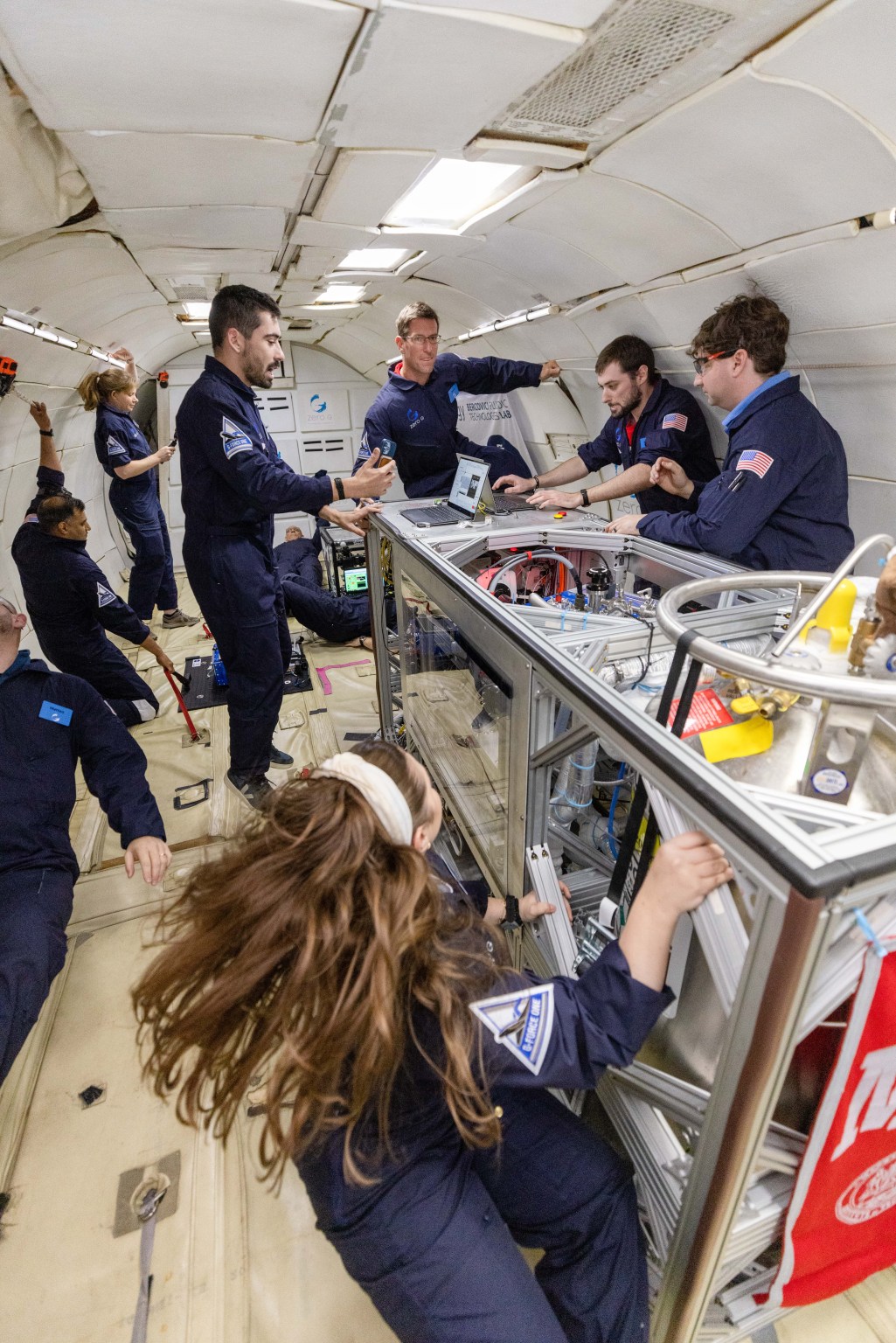
Technologies tested on the above campaign:
- Autonomous Sampling Technology for Biological Research During Suborbital Rocket Flight (Mayo Clinic)
- Measuring Cryogenic Two-Phase Heat Transfer Coefficients for Future In-Space Transfer Systems (Purdue University)
- Determination of Cryogenic Pool Boiling and Subsurface Helium Pressurization Characteristics in Reduced Gravity (University of Florida)
- CFD Boiling Models for Cryogenic Fluid Management Systems (Massachusetts Institute of Technology)
- Low-Cost Three-Axis CubeSat Attitude Control with Hard Disk Drive Reaction Wheels (University of California – Davis)
- Microfluidic Biochemical Analysis Lab-on-a-Chip (University of California – Berkeley)
- Integrating Microgravity Medical Suction and Microgravity Surgical Facility (Purdue University)
- Computed Axial Lithography for Rapid Volumetric Additive Manufacturing Under Low-Gravity Conditions (University of California – Berkeley)
- Fluidic Telescope Experiment (FLUTE) (NASA’s Ames Research Center)
- Goggle-Based Visual Field (GBVF) Device for Spaceflight-Associated Neuro-Ocular Syndrome (NASA’s Johnson Space Center)
- Neuroscience Tilt-Board Inflight Trainer to Maintain Sensorimotor Conditioning (NASA’s Johnson Space Center)
August 3, 2022
Satellite System for Plume Identification Tested on High-Altitude Balloon
Technologies tested may contribute to monitoring of fire, pollution, and volcanic activities. Payloads were tested aboard Aerostar’s Zero-Pressure Balloon System out of Sioux Falls, South Dakota.
Developed by TechLeap Prize-winning students at Texas A&M’s Systems Engineering, Architecture, and Knowledge (SEAK) Lab, the Satellite for Natural and Artificial Plumes (SNAP) uses gimbaled cameras to collect image data and a computing system to process the data using a trained neural network to identify and track Earth-based plumes. This balloon flight enabled image collection and testing of SNAP’s plume tracking capability as well as identification of necessary improvements to its onboard computing system in advance of a second flight slated for 2023.
Learn more about the TechLeap Prize about Satellite System for Plume Identification Tested on High-Altitude Balloon
Technology tested on the above campaign:
- Satellite for Natural and Artificial Plumes (Texas A&M’s SEAK Lab)
July 28, 2022
Quantum Machine Learning Technology for Earth Observation Tested on High-Altitude Balloon
This technology could significantly reduce the bandwidth needed for small spacecraft to send data about terrestrial events back to Earth. Payloads were tested aboard Aerostar’s Zero-Pressure Balloon System out of Sioux Falls, South Dakota.
TechLeap Prize winner Orion Labs developed and tested the Quantum Earth Observatory (QEOBS) – a four unit-sized CubeSat designed to demonstrate how onboard data processing and quantum machine learning can result in reduced downlink requirements. During the flight, QEOBS collected thousands of images of small dams and waterways, processing the image data onboard and efficiently downlinking only data about confirmed dam detections to the ground. The flight results will help the team identify specific Earth observation use cases for the technology and prepare for a potential future demonstration on a small spacecraft.
Learn more about this flight about Quantum Machine Learning Technology for Earth Observation Tested on High-Altitude Balloon
Technology tested on the above campaign:
- Quantum Earth Observatory (Orion Labs)
July 8, 2022
Wildfire Detection System Tested on High-Altitude Balloon
This balloon flight is advancing a system designed to provide potentially faster, more accurate aerial detection of nascent wildfires. Payloads were tested aboard Aerostar’s Zero-Pressure Balloon System out of Sioux Falls, South Dakota.
Student members of TechLeap Prize winner Bronco Space Lab at Cal Poly Pomona developed and launched a wildfire detection system called Bronco Ember. Combining a short-wave infrared camera with artificial intelligence, the system is designed to provide potentially faster, more accurate aerial detection of nascent wildfires, which often go undetected by current geolocation methods. This balloon flight enabled the team to evaluate the technology’s efficacy and identify necessary improvements to its detection and tracking consistency – refinements they plan for the next generation of Bronco Ember.
Learn more about this flight about Wildfire Detection System Tested on High-Altitude Balloon
Technologies tested on the above campaign:
- Bronco Ember: Autonomous Nascent Wildfire Detection and Prevention (Bronco Space Lab at California State Polytechnic University)
June 27-28, 2022
Cryogenic Management, Space-Based Manufacturing, and Small Spacecraft Technologies Tested on Parabolic Flights
Post-flight analyses inform future payload design changes, helping to mature the technologies in advance of future flight tests and potential mission infusion. Payloads were tested aboard Zero Gravity Corporation’s G-FORCE ONE out of Santa Maria, California.
This flight campaign provided two flights on consecutive days, allowing research teams supported by NASA’s TechFlights awards from both industry and academia to test technologies designed for a range of space-based capabilities. Exposure to both zero gravity and lunar gravity enabled teams to evaluate the performance of their payloads and make adjustments between flights.
Learn more about NASA TechFlights about Cryogenic Management, Space-Based Manufacturing, and Small Spacecraft Technologies Tested on Parabolic Flights
Technologies tested on the above campaign:
- CubeSat Articulated Boom Option Optimization in Microgravity (University of Iowa)
- Low-Cost Three-Axis CubeSat Attitude Control With Hard Disk Drive Reaction Wheels (University of California – Davis)
- Capturing Human Adaptations in Novel Gravitational Environments in Space (University of California – Davis)
- Cryogenic Two-Phase Heat Transfer Coefficients for Future In-Space Transfer Systems (Purdue University)
- Plasma Jet Printing for In-Space Manufacturing (Space Foundry)
May 9-12 and 16-17, 2022
Payloads for Additive Manufacturing, Biotechnology, and More Tested on Parabolic Flights
Brief periods of microgravity enabled the teams to test the performance of their payloads in one of the challenging environments of space. Payloads were tested aboard Zero Gravity Corporation’s G-FORCE ONE out of Fort Lauderdale, Florida.
These two parabolic flight campaigns provided testing aboard the G-FORCE ONE aircraft for innovations designed for space-based biotech, surgery, 3D printing, power systems, and propellant gauging. Flights were funded by Flight Opportunities though a wide variety of NASA mechanisms (e.g., TechFlights awards, SBIR, Tipping Point awards).
Learn more about NASA TechFlights about Payloads for Additive Manufacturing, Biotechnology, and More Tested on Parabolic Flights
Technologies tested on the above campaign:
- Propellant Gauging During On-Orbit Refueling and Transfer Operations (Carthage College)
- Microfluidic Biochemical Analysis Lab-on-a-Chip (University of California, Berkeley)
- Preparations for a Suborbital Evaluation of a Human Tended Surgical Fluid Management System (University of Louisville)
- Computed Axial Lithography for Rapid, Volumetric Additive Manufacturing (University of California, Berkeley)
- Lightweight, Hybrid Screen-Channel Device for Advanced Cryogenic Fluid Management (Creare)
- 3D Printing of Flexible Electronics for In-Space Manufacturing (Iowa State University)
- Propellant Mass Gauging in Microgravity with Electrical Capacitance Tomography (NASA’s Kennedy Space Center)
- Hydrogen Electrical Power System (Teledyne Energy Systems)
- Novel Technology for a Key Material Property Measurement – Application to Advanced Manufacturing in Space (University of Florida)
- Reduced Gravity Experiments to Advance CFD Boiling Models for Cryogenic Fluid Management Systems (Massachusetts Institute of Technology)
- Particle-Based Foams Spraying in Microgravity (West Virginia University)
April 9-13, 2022
Sensor for Improved Weather Data Collection Tested on High-Altitude Balloon
The CubeSounder technology could benefit future balloon flights and CubeSats by enabling state-of-the-art atmospheric sounding capabilities that reveal subtle changes in the Earth’s atmosphere. Payloads were tested aboard World View Enterprises’ Stratollite® high-altitude balloon out of Tucson, Arizona.
This flight enabled testing of a small, lightweight, efficient 3D imaging sensor designed for weather forecasting from Arizona State University. The sensors probe the sky vertically for details on temperature, moisture, and water vapor to reveal subtle changes in the Earth’s atmosphere. In this first of two NASA-supported flight tests for the technology, World View’s Stratollite balloon reached a stratospheric altitude of approximately 70,000 feet. Over more than 100 hours of flight time, the CubeSounder collected atmospheric temperature and humidity data as 3D images – data that could ultimately be downlinked at high speeds from CubeSats or weather balloons and compared with that of other weather satellites and ground stations.
Learn more about this flight about Sensor for Improved Weather Data Collection Tested on High-Altitude Balloon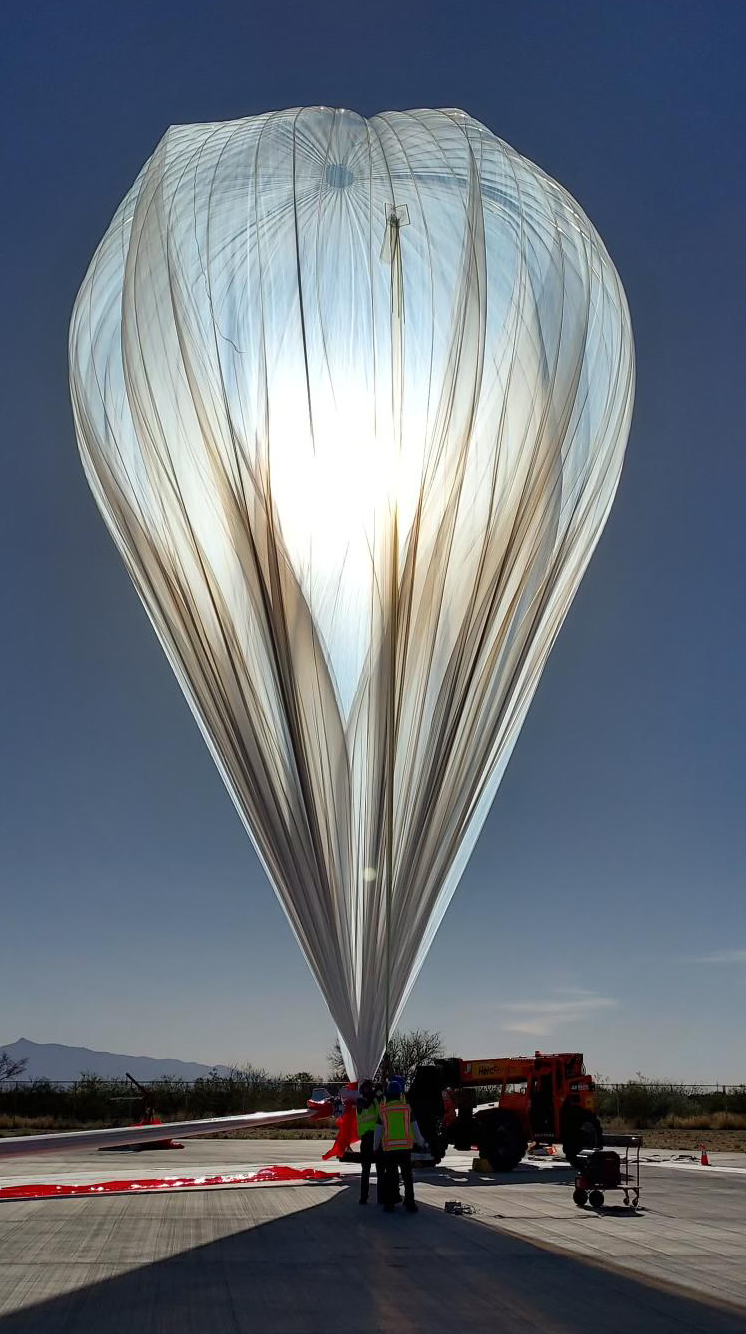
Technology tested on the above campaign:
- CubeSounder (Arizona State University)
2021 Flights
December 7-15, 2021
Tech Designed for Space-Based First Aid, CubeSat Attitude Control, and More Tested on Parabolic Flights
These flights enabled research teams to leverage periods of microgravity to test their innovations. Payloads were tested aboard Zero Gravity Corporation’s G-FORCE ONE out of Orlando, Florida
This week of parabolic flights provided testing for a wide range of Flight Opportunities–supported technologies. Research teams leveraged periods of microgravity to test innovations designed for space-based first aid, 3D printing, robotics, and more. Several technologies were also able to apply lessons learned from parabolic flights in November and rapidly refly on these flights just one month later.
Learn more about this flight about Tech Designed for Space-Based First Aid, CubeSat Attitude Control, and More Tested on Parabolic Flights
Technologies tested on the above campaign:
- SmallSat Propellant Management Technology (Purdue University)
- Enhancing Suborbital Tech Advancement Through Automated Control of High-Def Video Systems (Purdue University)
- Autonomous Robot Swarms for Lunar Orbit Servicing and Space Asset Assembly (Massachusetts Institute of Technology)
- Microgreens Root Zone/Shoot Zone Partitioned Planting Box (NASA’s Kennedy Space Center)
- 3D Printing of Flexible Electronics for In-Space Manufacturing (Iowa State University)
- Plasma Jet Printing for In-Space Manufacturing (Space Foundry)
- Integrating Microgravity Medical Suction and Microgravity Surgical Facility (Purdue University)
- Strata-2P: Characterizing Sensor-Regolith Interactions in Reduced Gravity (University of Central Florida)
- Soil Properties Assessment Resistance and Thermal Analysis (SPARTA) (NASA’s Jet Propulsion Laboratory)
- Testing a Novel Technology for a Key Material Property Measurement (University of Florida)
- Low-Cost Three-Axis CubeSat Attitude Control with Hard Disk Drive Reaction Wheels (University of California – Davis)
- Capturing Human Adaptations in Novel Gravitational Environments in Space (CHANGES) (University of California – Davis)
- Space Fibers 3 Preflight (NASA’s Johnson Space Center)
November 16-19, 2021
Tech Designed for Space-Based Farming, Additive Manufacturing, and More Tested on Parabolic Flights
These flight tests helped researchers prepare their payloads for potential use in future NASA missions. Payloads were tested aboard Zero Gravity Corporation’s G-FORCE ONE out of Orlando, Florida.
These flights provided a unique testing environment for space innovations supported by Flight Opportunities. Technologies designed for space farming, 3D printing, on-orbit refueling, and more were put to the test during these flights that provide brief periods of microgravity.
Learn more about this flight about Tech Designed for Space-Based Farming, Additive Manufacturing, and More Tested on Parabolic Flights
Technologies tested on the above campaign:
- Microgravity Test of Autonomous Multiple Cycle Farming System (Florida Institute of Technology)
- Propellant Gauging During On-Orbit Refueling and Transfer Operations (Carthage College)
- Particle-Based Foams Spraying in Microgravity (West Virginia University)
- Vulcan Advanced Hybrid Manufacturing (Redwire)
- Plasma Jet Printing for In-Space Manufacturing (Space Foundry)
- Electrowetting Enhanced Dropwise Condensation in the Zero-g Environment (University of Missouri)
- Silicon-based Microfluidic Blood Test for Spaceflight (IMEC USA Nanoelectronics Design Center)
- Microgreens Root Zone/Shoot Zone Partitioned Planting Box (NASA’s Kennedy Space Center)
- Microgravity Propellant Gauging Using Modal Analysis: Phase III (Carthage College)
October 19, 2021
On Demand Payload Delivery Capsule Tested on High-Altitude Balloon
The guided re-entry capsule tested during this flight could one day be used for on-demand transport of payloads back to Earth. Payloads were tested aboard Near Space Corporation’s Small Balloon System out of Madras, Oregon.
This flight enabled testing of a payload return capsule called the Re-entry Device 4U (RED-4U). The capsule was suspended under a high-altitude balloon and released at an altitude of 103,000 feet. It landed within 250 feet of the target touch-down destination, thanks to a guided parafoil. The demonstration was a milestone for evaluating the capsule’s altitude-detection capabilities and the parafoil’s autonomous guidance and control and brings the technology a step closer to potential space-based uses. Approximately 20 inches in diameter, the guided re-entry capsule could one day be used for on-demand transport back to Earth of payloads up to about 18 pounds. It could carry materials manufactured in space for use on Earth, small instruments and tools, biological samples, and science experiments from low-Earth orbit destinations.
Learn more about this flight about On Demand Payload Delivery Capsule Tested on High-Altitude Balloon
Technology tested on the above campaign:
- Enabling Low-Cost, Autonomous Recovery of Small Payloads from Low-Earth Orbit (SpaceWorks Enterprises)
October 14, 2021
High Tech Video Technology and Regolith Sensor Tested on Vertical Takeoff Vertical Landing System
This testing was designed to help researchers understand the limit of how far from a planetary surface they would need to eject the payload in order for it to survive landing and function properly. Payloads were tested aboard Masten’s Xodiac out of Mojave, California.
Video capture during future lunar landings could play an important role in contributing to researchers’ understanding of disturbances in lunar surface materials – called regolith – caused by the lander’s rocket plume. This flight test leveraged Masten’s vertical takeoff vertical landing (VTVL) platform to simulate the movement of a lunar lander, enabling researchers to test an ejection mechanism to jettison a high-tech camera and regolith sensor onto the desert surface at specific altitudes just before landing. Once on the ground, the payload’s camera captured video footage from the unique vantage point of the desert surface – a stand-in for the surface of the Moon.
Learn more about this flight about High Tech Video Technology and Regolith Sensor Tested on Vertical Takeoff Vertical Landing System
Technology tested on the above campaign:
- ExoCam Module Lunar Lander Descent Imaging (Zandef Deksit)
August 26, 2021
Technologies to Study Lunar Dust, Space-Based Biology, and More Tested on Rocket-Based System
This flight helped advance NASA’s trash-to-gas technology, OSCAR, as well as an experiment designed to help understand shifts in biological organisms as they transition between varying levels of gravity. Payloads were tested aboard Blue Origin’s New Shepard out of Van Horn, Texas.
In Blue Origin’s 17th New Shepard mission, the fully reusable launch vehicle carried technologies from NASA, industry, and academia aboard for just over 10 minutes. The vehicle reached an apogee of nearly 350,000 feet, exposing the payloads aboard to some of the conditions they will need to withstand in potential future orbital missions. Key milestones included the second suborbital flight test of NASA’s trash-to-gas technology, OSCAR, as well as the third suborbital flight test for a University of Florida experiment designed to understand shifts in biological organisms as they transition between varying levels of gravity.
Learn more about this flight about Technologies to Study Lunar Dust, Space-Based Biology, and More Tested on Rocket-Based System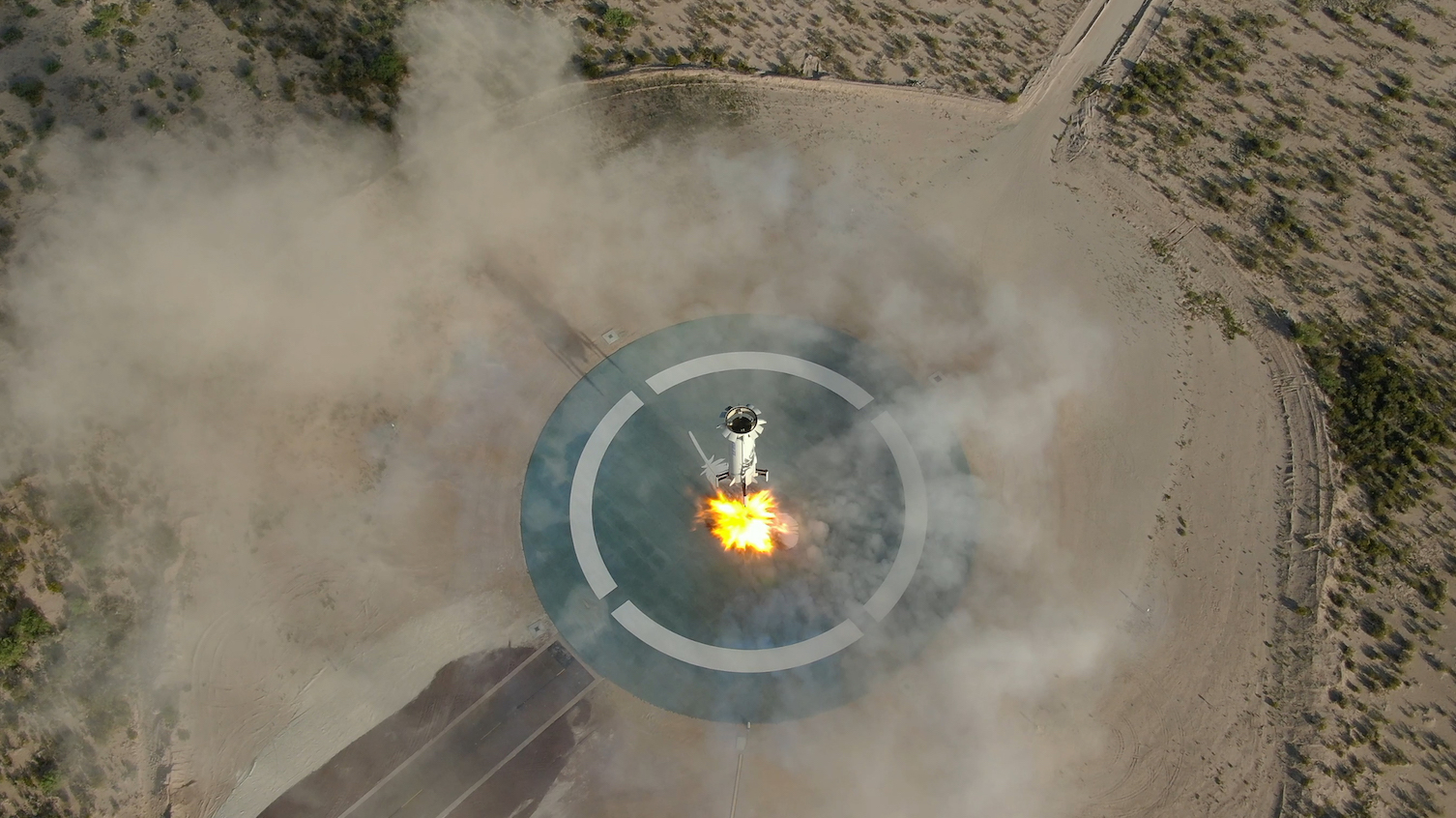
Technologies tested on the above campaign:
- Rotational Stability of On-Orbit Propellant Storage and Transfer (Zero Gravity Horizons)
- Dust In-situ Manipulation System (University of Central Florida)
- Liquid Acquisition Device for Cryogenic Fluid Management (Southwest Research Institute)
- Propellant Mass Gauging in Gateway Architecture Vehicles (Carthage College)
- Biological Imaging in Support of Suborbital Science (University of Florida – Gainesville)
July 27, 2021; September 22, 2021
Radiation-Tolerant Computing System Tested on High-Altitude Balloon
This flight provided critical preparation for future assessment of a radiation-tolerant computing system and its functionality in long-duration space missions. Payloads were tested aboard Raven Aerostar’s Super Pressure Balloon System out of Sioux Falls, South Dakota.
Two high-altitude balloon flights enabled researchers to test a radiation-tolerant computing system called RadPC. The innovation is designed to replace failed processors in real time – and testing was needed to make sure the computing system can withstand the high-energy radiation particles emitted by the Sun and other celestial bodies. During more than 80 hours of flight time, researchers tested the computing technology against more than 3,000 injected system faults; the RadPC recovered from all of them successfully. The flights added to data collected during many other suborbital flights facilitated by Flight Opportunities, including sounding rocket and other balloon flights. The testing and validation were also critical preparation for a planned 2023 lunar demonstration of RadPC, which will enable assessment of its functionality for long-duration space missions.
Learn more about this flight about Radiation-Tolerant Computing System Tested on High-Altitude Balloon
Technology tested on the above campaign:
- RadPC@scale (Montana State University)
June 14, 2021
Advanced Cloud Sensor Tested on High-Altitude Balloon
The new nephelometer tested here may provide information about a cloud’s water content as well as its impact on a planet’s atmosphere or thermal and radiation environments. Payloads were tested aboard Raven Aerostar’s Zero-Pressure Balloon System out of Baltic, South Dakota.
This flight test enabled researchers to assess a new nephelometer called NephEx, a sensor that measures light scattering by airborne particles, including cloud droplets and ice particles. NephEx could also supplement common techniques for cloud and climate monitoring, such as remote sensing via satellite. The high-altitude balloon flight provided an important step in maturing the technology and assessing its capabilities to measure the size, concentration, and distribution of cloud particles – data critical to understanding the impact of clouds on a planet’s climate.
Learn more about this flight about Advanced Cloud Sensor Tested on High-Altitude Balloon
Technology tested on the above campaign:
- NephEx (NASA’s Ames Research Center)
June 1-6, 2021
Turbulence Detection Technologies Tested on Hybrid Balloon/Glider System
These flights enabled testing of instruments designed to aid turbulence detection for remote-piloted and autonomous aerial vehicles, including commercial aircraft and on-demand delivery drones. Payloads were tested aboard Stratodynamics’ HiDRON out of Truth or Consequences, New Mexico.
This series of flights provided by Stratodynamics Inc. of Lewes, Delaware, leveraged the company’s HiDRON stratospheric glider. The glider launched from a high-altitude balloon at Spaceport America in New Mexico, carrying technology supported by NASA’s Flight Opportunities program for the first time. The flights aimed to help researchers assess the performance of both a wind probe developed by the University of Kentucky in Lexington and an infrasonic microphone sensor, developed by researchers at Langley and licensed by Stratodynamics in 2020. The flights enabled cross validation of the sensor with the wind probe. The HiDRON glider enabled the instruments to capture wind velocity, direction, magnitude, and low-frequency sound waves.
Learn more about this flight about Turbulence Detection Technologies Tested on Hybrid Balloon/Glider System
Technology tested on the above campaign:
- Forward-Sensing Turbulence Detection Strategies for Stratospheric Flight (University of Kentucky)
May 22, 2021
Suborbital Sensor Suite, Dust Experiment, and Space-Based Surgical System Tested on Rocket-Powered Space Plane
The technologies tested on this flight were designed to provide information about the environmental conditions inside a spacecraft; the behavior of dust and fine particles in response to human and robotic activities in space; and a system to help facilitate wound care in microgravity conditions. Payloads were tested aboard Virgin Galactic’s SpaceShipTwo out of Truth or Consequences, New Mexico.
Taking off for the first time from New Mexico’s Spaceport America and reaching an altitude of more than 50 miles (80 kilometers), Virgin Galactic’s SpaceShipTwo exposed several Flight Opportunities-supported payloads to more than two minutes of microgravity, enabling researchers to assess performance and make necessary design updates based on the data collected. The technologies aboard included a sensor suite designed to provide suborbital researchers with vital information about the environmental conditions inside a spacecraft; a dust experiment that aims to advance our understanding of the behavior of dust and fine particles in response to human and robotic activities in space; and a space-based surgical system designed to help facilitate wound care in microgravity conditions.
Learn more about this flight about Suborbital Sensor Suite, Dust Experiment, and Space-Based Surgical System Tested on Rocket-Powered Space Plane
Technologies tested on the above campaign:
- JANUS 3.0 (Johns Hopkins University’s Applied Physics Lab)
- Collisions Into Dust Experiment (University of Central Florida)
- Aqueous Immersion Surgical System (University of Louisville)
May 4-7, 2021
Long-Term Food Storage, Autonomous Lunar Robots, Origami-Inspired Solar Arrays, and More Tested on Parabolic Flights
This series of flights allowed research teams to leverage brief periods of microgravity to test their innovations. Payloads were tested aboard Zero Gravity Corporation’s G-FORCE ONE out of Fort Lauderdale, Florida.
This series of parabolic flights provided testing for a wide range of Flight Opportunities-supported technologies. Research teams leveraged brief periods of microgravity to test innovations designed for structural inspections and servicing, space-based blood transfusions, propellant management, surgical fluid management, space-based manufacturing, and more.
View photos from this flight—THIS LINK HAS NO PHOTOS about Long-Term Food Storage, Autonomous Lunar Robots, Origami-Inspired Solar Arrays, and More Tested on Parabolic Flights
Technologies tested on the above campaign:
- Microgravity Propellant Gauging Using Modal Analysis: Phase III (Carthage College)
- Evaluation of Preserved Blood for Transfusion Therapy (University of Louisville)
- Vapor Compression Refrigeration System for Cold Food Storage (Air Squared)
- Composite Origami for Spacecraft Solar Arrays and Deployable Structures (North Carolina State University)
- Preparations for a Human-Tended Surgical Fluid Management System (University of Louisville)
- Smallsat Propellant Management Technology (Purdue University)
- Propellant Mass Gauging in Gateway Architecture Vehicles (Carthage College)
- Glass Alloy Manufacturing Machine – Acoustic Levitation Furnace (Redwire)
- Autonomous Robot Swarms for Lunar Orbit Servicing and Space Asset Assembly (MIT)
April 28-30, 2021
Biomedical Research Technology, CubeSat Boom, and Manufacturing Method for Life Support Systems Tested on Parabolic Flights
These flights were critical to evaluating ring-sheared drop and fluid dispensing experiments from NASA’s Marshall Space Flight Center and Rensselaer Polytechnic Institute ahead of deployment on the International Space Station. Payloads were tested aboard Zero Gravity Corporation’s G-FORCE ONE out of Fort Lauderdale, Florida.
This series of parabolic flights provided testing for several Flight Opportunities-supported technologies. The experiment is designed to study the formation of potentially destructive amyloid fibrils, or protein clusters, like those found in the brain tissue of patients with neurodegenerative diseases such as Alzheimer’s and Parkinson’s. Conducting the experiment in microgravity enables researchers to “pin” a droplet of liquid between two rings and cultivate amyloid fibrils for study. The flights enabled the research team to demonstrate that their hardware is capable of deploying and pinning each of the protein solutions that will be used on the station to help advance neurodegenerative disease research.
Learn more about this flight about Biomedical Research Technology, CubeSat Boom, and Manufacturing Method for Life Support Systems Tested on Parabolic Flights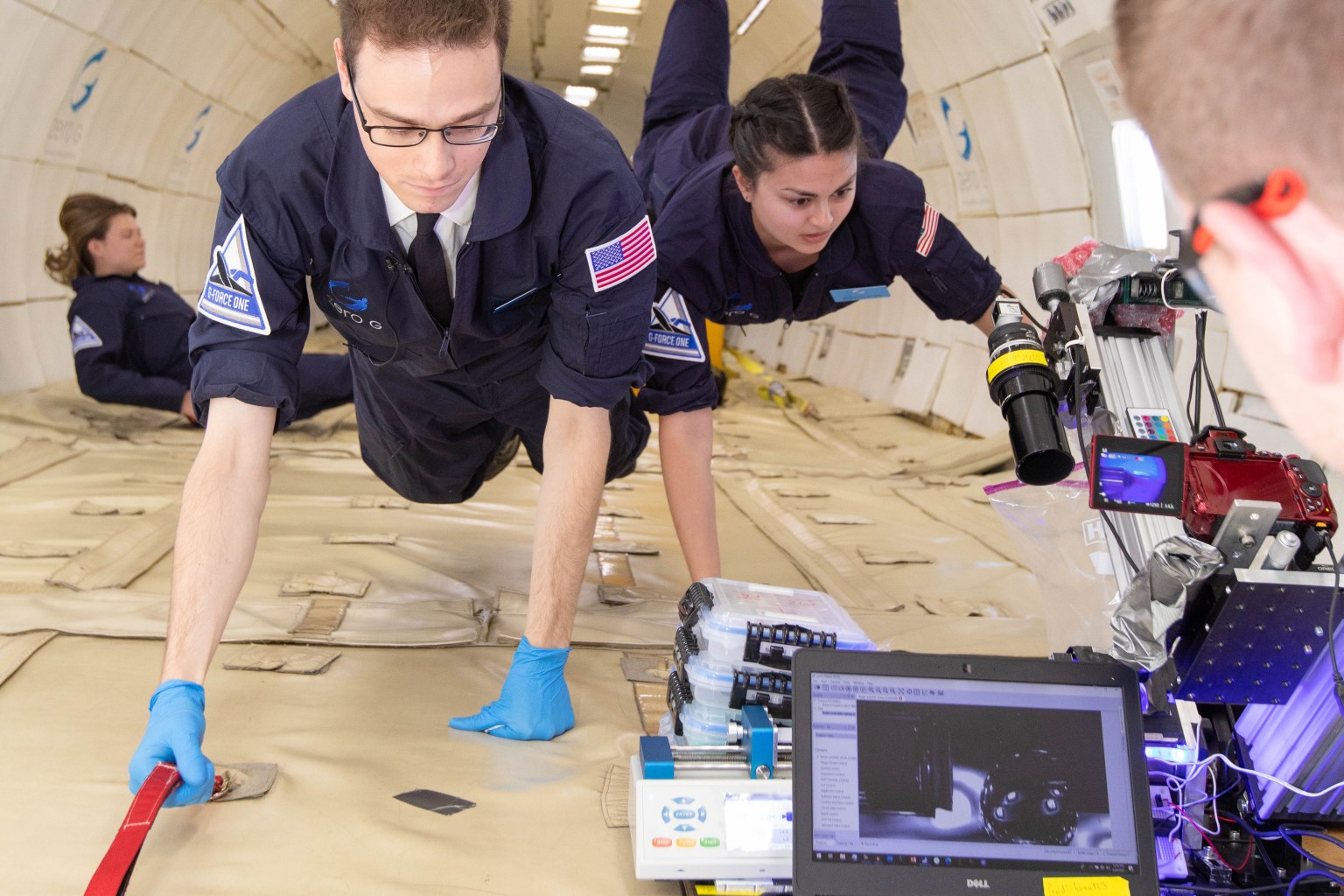
Technologies tested on the above campaign:
- Adapting the Ring-Sheared Drop Technology as a Bioreactor (Rensselaer Polytechnical Institute)
- Fluid Dispensing Tube Limits for Drop Delivery (NASA’s Marshall Space Flight Center)
- CubeSat Articulated Boom Option Optimization in Microgravity (University of Iowa)
- Lunar Manufacturing of Life Support Systems Using a Direct-Writing Technique (University of Colorado – Boulder)
April 15, 2021
Small Payload Delivery System Tested on High-Altitude Balloon
This flight provided an important preparatory step for future testing of a technology designed to carry research samples and other small payloads from astronauts on the International Space Station back to Earth. Payloads were tested aboard Near Space Corporation’s Small Balloon System out of Madras, Oregon.
This balloon flight enabled testing of an 11-inch diameter small payload delivery system called the KREPE capsule (previously referred to as the KRUPS capsule) designed to carry research samples and other small payloads from astronauts on the International Space Station back to Earth. Although the balloon reached an altitude of approximately 100,000 feet, the conditions did not expose KRUPS to the temperatures needed to test its thermal protection system (TPS). However, the test did provide an important preparatory step in advance of a subsequent orbital test of the capsule and its TPS.
Learn more about this flight about Small Payload Delivery System Tested on High-Altitude Balloon
Technology tested on the above campaign:
- Kentucky Re-entry Universal Payload System (University of Kentucky)
March 12, 2021
Advanced Communications Technology for CubeSat Swarms Tested on High-Altitude Balloon
This flight enabled testing of the V-R3x technology, designed to support advanced communications and navigation capabilities among coordinated groups – or swarms – of CubeSats. Payloads were tested aboard Raven Aerostar’s Zero Pressure Balloon System out of Madras, Oregon.
Specifically, the flight allowed researchers to evaluate V-R3x’s advanced swarm communications by forming a mesh network between multiple spacecraft and ground stations. The flight data was to be added to that of an orbital flight test of three V-R3x CubeSats that launched to space in January 2021.
Learn more about this flight about Advanced Communications Technology for CubeSat Swarms Tested on High-Altitude Balloon
Technology tested on the above campaign:
- V-R3x (NASA’s Ames Research Center, Stanford University)
Learn More and Get Involved

Commercial Flight Providers
When non-U.S. government researchers compete for funding through the Flight Opportunities program's TechFlights solicitation, they can propose to use any viable U.S.-based commercial provider. For U.S. government research, NASA has IDIQ (Indefinite Delivery/Indefinite Quantity) contracts with several flight services vendors.





























